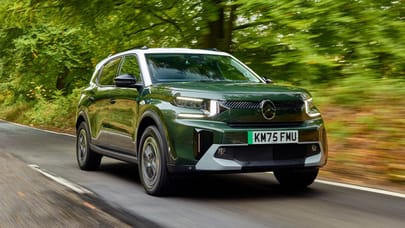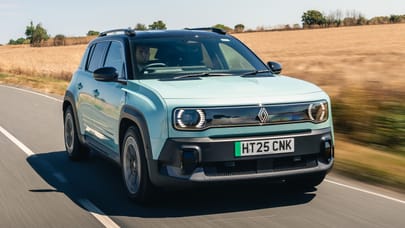
Good stuff
Appealing price tag, simple approach, low (ish) weight
Bad stuff
Cabin doesn't inspire like its Citroen twin, wind noise
Overview
What is it?
It’s the new Vauxhall Frontera, making its return after a 20-year absence. This Frontera definitely isn’t the old one, though, and it absolutely definitely isn’t a rebadged Isuzu MU, as was the case two decades ago.
Indeed, there’s no mistaking it as a Vauxhall thanks to that Vizor front end, while there’s a Dacia-ness to its rugged looks, particularly on steel wheels (you want the steel wheels). It sits between the bigger Grandland and smaller Mokka, sharing roughly the same footprint as an Astra hatchback but with a slightly bigger boot.
It’s available with a fully electric (in case you hadn’t guessed by the name) or mild-hybrid powertrain, our full review of which is here. Since we first drove the cars, Vauxhall has tinkered with the price list and the UK government has launched its latest grant scheme. The end product of which is this electric version starting below £23,000, post-grant, and thus cheaper than the hybrid. Wow.
Tell me more of this electric powertrain, please…
You get a 111bhp electric motor mated to either a 44kWh (usable) or 54kWh battery for 186 or 253 miles of range. Anyone who’s been paying attention to TopGear.com recently will note that’s the same powertrain as you find in the Citroen e-C3 and e-C3 Aircross, with which it shares the same ‘Smart Car’ BEV platform, as well as the new Fiat Grande Panda.
So, it’s not going to get you from London to Edinburgh on one charge, but that’s not Vauxhall’s aim here. The firm is pushing hard to eliminate the price disparity that usually exists between electric and petrol cars; a 31 per cent premium, it reckons. The Frontera Electric is here to vociferously challenge that.
Is the Frontera Electric any good?
It’s not going to have you all hot under the collar at the thought of driving it, but it goes well enough. It’s all very leisurely, from the steering to the acceleration to the brakes, and seems geared for comfort more than anything else. Which seems well judged for its target audience. Full details on the Driving tab.
And it’s a similar story inside, where it lacks the glitz and glamour of some rivals but feels fit for purpose. Clean surfaces, minimal distractions, reasonable space. All versions get dual 10-inch screens and physical climate controls (hurrah!).
Upper-spec models get front Intelli-Seats, complete with a slot that helps to relieve the pressure on the tailbone, while there’s good room in the back too. But unlike the mild hybrid there’s no seven-seat option here, on account of the battery. Click through to the Interior tab for the full lowdown.
What about rivals?
It’s not short of them. Within Stellantis there’s the e-C3 Aircross, Fiat 600e, Jeep Avenger and Peugeot e-2008, while there’s also the Hyundai Kona Electric, Kia Soul EV, MG S5 and the Ford Puma Gen E to consider. Not to mention the coolest car in this class, the TG Award-winning Renault 4.
Our choice from the range

What's the verdict?
The Vauxhall Frontera Electric feels well judged. It's played with a pretty straight bat, blending plain but agreeable dynamics with the kind of rugged looks people favour these days. And above all there’s no arguing with the cost.
A lower price than the mild-hybrid is an arresting USP, and it may well tempt some sceptics to finally go electric, particularly those who can take advantage of home charging. There's also tonnes of offers available to help convince all users that electric isn't all that scary.
Giveaway deals feel as Nineties as the Frontera badge itself, and perhaps nostalgia is the key to shifting enough EVs to meet increasingly stringent targets. The Renault 4 offers an even longer throwback, after all...
The Rivals
Trending this week
- Car Review
Renault Clio







